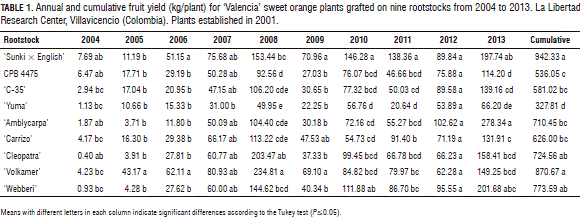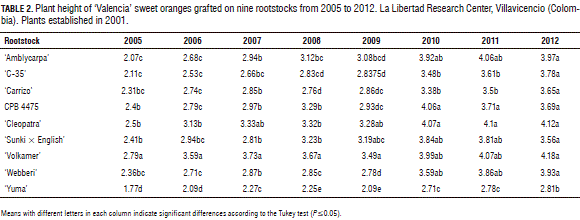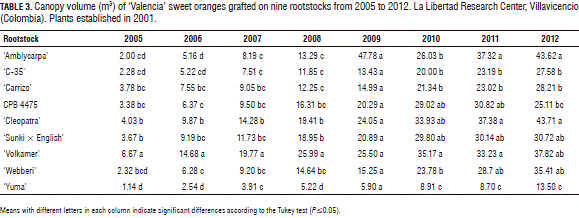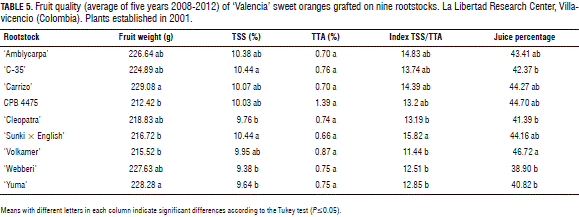Services on Demand
Journal
Article
Indicators
-
 Cited by SciELO
Cited by SciELO -
 Access statistics
Access statistics
Related links
-
 Cited by Google
Cited by Google -
 Similars in
SciELO
Similars in
SciELO -
 Similars in Google
Similars in Google
Share
Agronomía Colombiana
Print version ISSN 0120-9965
Agron. colomb. vol.33 no.1 Bogotá Jan./Apr. 2015
https://doi.org/10.15446/agron.colomb.v33n1.49497
Doi: 10.15446/agron.colomb.v33n1.49497
1 La Libertad Research Center, Corporacion Colombiana de Investigacion Agropecuaria (Corpoica). Villavicencio (Colombia). jorduz@corpoica.org.co
Received for publication: 5 February, 2015. Accepted for publication: 30 March, 2015.
ABSTRACT
'Valencia' sweet orange is widely cultivated in Colombian tropical lowlands, with low yields and a lack of technology. As a result, nine rootstocks commonly used in tropical zones: 'C-35', 'Carrizo', 'Swingle' citrumelo or CPB 4475, 'Cleopatra', 'Sunki × English', 'Volkamer', 'Webberi' and 'Yuma' were evaluated. The plants were established in 2001 and were evaluated for vegetative growth, fruit yield and quality for 10 years (2004-2013). The obtained results indicated that 'Sunki × English' and 'Volkamer' were the best rootstocks for fruit yield and the worst was 'Yuma'. Furthermore, all of the rootstocks, except 'Yuma', stabilized their height in the last year. In terms of volume, 'Amblycarpa' and 'Cleopatra' were the bigger plants and 'Yuma' was the smallest. In addition, for yield efficiency, 'Yuma' had the best rootstocks, followed by 'Sunki × English'. All of the rootstocks showed a similar fruit quality, except for 'Sunki × English', which obtained the highest total soluble solids/total titratable acids ratio.
Key words: ecophysiology, fruit quality, genotype, propagation, Citrus.
RESUMEN
La naranja 'Valencia' es ampliamente cultivada en el trópico bajo de Colombia, con bajos rendimientos y falta de tecnología. Para responder a estos requerimientos, fueron evaluados nueve patrones comúnmente usados en las zonas tropicales, 'C-35', 'Carrizo', 'Swingle' citrumelo o CPB 4475, 'Cleopatra', 'Sunki × English', 'Volkameriano', 'Webberi' y 'Yuma'. Las plantas fueron establecidas en el año 2001, se evaluaron por 10 años (2004-2013) las variables de crecimiento vegetativo, rendimiento y calidad de fruta. 'Sunki × English' y 'Volkameriana' fueron los patrones con más alto rendimiento de fruta, el menor fue 'Yuma'. Todos los patrones, excepto 'Yuma' estabilizaron su altura en el último año. En volumen 'Amblycarpa' y 'Cleopatra' produjeron las plantas más grandes, y 'Yuma' el más pequeño. El patrón con mejor eficiencia de copa es 'Yuma' seguido por 'Sunki × English'. Todos los patrones presentaron frutas de calidad similar, excepto por 'Sunki × English' el cual obtuvo una relación alta de sólidos solubles totales/acidez total titulable.
Palabras clave: ecofisiología, calidad de la fruta, genotipo, propagación, Citrus.
Introduction
The production of citrus is possible in tropical and subtropical zones and tropical zones are located between 23.5° North and South latitude. In addition, citrus is cultivated between 0 and 2,000 m a.s.l. (Orduz-Rodríguez et al., 2011) and is produced in tropic highlands (1,500-2,000 m a.s.l.), medium lands (800-1,500 m a.s.l.) and lowlands (0-700 m a.s.l.) (Orduz-Rodríguez, 2007). However, 'Valencia' sweet oranges offer the best economic performance in citrus fruits for tropic lowlands (Mateus et al., 2010) and are classified as a late harvest crop (Davies and Jackson, 2009). In tropical lowland conditions, plants reach bigger sizes than in subtropical and tropical conditions (Reuther, 1977).
Under tropical conditions, the flowering intensity, duration and distribution are due to water stress (Davenport, 1990). Furthermore, the fruit growth is fast with a poor external quality, green rind, pallid yellow colored fruit, and low total soluble solids and total titratable acid due to the fact that the average temperature remains high all year, causing high respiratory rates that metabolize sugars and acids (Davies and Albrigo, 1994).
The evaluation of rootstock is vital for the commercial development of citrus crops due to the fact that the rootstock affects more than 20 horticultural variables of citrus plants (Davies and Albrigo, 1994), including yield. This kind of investigation must be done locally, according to the plant response to the weather, soil, disease and crop management (Wutscher and Bistline, 1988). As a result, the response of the rootstocks to the mentioned variables could improve the actual productive capacity of the 'Valencia' sweet orange trees grafted over the 'Cleopatra' tangerine that has been used due to its resistance to Phytophthora (Castle, 1987). 'Cleopatra' is classified as a rootstock with a late production entrance. In the end, selecting new rootstocks and understanding the productive, vegetative and fruit quality behavior provide information for making decisions about yield, field distribution and quality of fruit according to market demands.
Materials and methods
The study was conducted in the equatorial lowland tropics at the Corpoica La Libertad Research Center (04°03' N, 73°29' W) in Villavicencio (Colombia), during 2001-2014. For this purpose, the following rootstocks were studied: 'Amblycarpa' (Citrus amblycarpa [Hassk.] Ochse), 'C-35' (Citrus sinensis [L.] Osb. × Poncirus trifoliata [L.] Raf.), 'Carrizo' (Citrus sinensis [L.] Osb. × Poncirus trifoliata [L.] Raf.), 'Swingle' citrumelo or CPB 4475 (Citrus paradisi Macfad. × Poncirus trifoliata [L.] Raf.), 'Cleopatra' (Citrus reshni hort. ex Tanaka), 'Sunki × English' (Poncirus trifoliata [L.] Raf. × Citrus sunki [Hayata] hort. ex Tanaka), 'Volkamer' (citrus limmonia Osbeck), 'Webberi' (Citrus webberii Wester), and 'Yuma' (Citrus sinensis [L.] Osb. × Poncirus trifoliata [L.] Raf.). The rootstocks were propagated from mother plants located at the Corpoica Palmira Research Center in Palmira (Colombia), and, after one year, the plants were grafted using inverted T-bud with 'Valencia' sweet orange (Citrus sinensis [L.] Osbeck) bud.
The budded plants were planted with a distance of 8 x 5 m using a randomized complete block design and the soil type was classified as Typic haplustox. For which, the texture components were 59.5% sand, 14.00% loam, and 26.5% clay, and the soil pH was 4.5. In addition, the experiment was surrounded by 'Valencia' sweet orange grafted over 'Cleopatra' rootstock, the soil surface was covered with forage peanut and weeds, and the plants were not irrigated. Lastly, the management of the crop was done according to the recommendations of Orduz-Rodríguez and Baquero (2003) for citrus on the Colombian eastern plains.
The fruits were collected and weighed every year, 2005-2014, for each tree as the result of flowering intensity of the corresponding year. Also, the information for plant growth was taken annually in the dry season between December and February, and the canopy volume was calculated using the Turrel (1946) formula, v = 0.5236 * H * D, where H is high and D is diameter. Furthermore, the yield efficiency index was calculated as the production/canopy volume, expressed as kg m-3, and fruit quality data from November to January were estimated from a sample of ten fruits for each rootstock per block; from this, the average fruit weight, total titratable acidity (TTA), total soluble solids (TSS), average juice percentage age, and TSS/TTA ratio were obtained. Each fruit was weighed and the juice was extracted with an electric squeezer. Then, the juice content was sized with a graduated pipet. Finally, the total soluble solids was determined with a Brixco handheld refractometer (Atago, Tokyo) and the total titratable acidity as the citric acid equivalent was measured by titration with 0.1 N NaOH.
All of the data were subjected to ANOVA and the mean comparison to a Tukey multiple range test. Proc GLM was used for the statistics SAS® v.9.3.
Results
Fruit yield
Fruit production started in the third year, except for 'Webberi' and 'Cleopatra', with the first harvest in the fourth year, and the production stabilized in the sixth year for the CPB 4475, C-35 -2007-. However, 'Carrizo', 'Sunki × English' and 'Volkamer' lemon stabilized their production in the 2006 fifth year with a production of 29.38, 51.15 and 62.11 kg/plant, respectively (Tab. 1). Finally, 'Yuma' was the last one to stabilized production, in 2008 with 49.95 kg/plant.

For the cumulative production, 'Sunki × English' was the rootstock that had the highest (942.34 kg/plant), followed by 'Volkamer' lemon (870.67 kg/plant) without significant differences. 'Yuma' showed the lowest cumulative production with (327 kg/plant).
Plant growth
Height
'Volkamer' lemon showed higher plants in the field during the years 2005-2009. However, the 'Yuma' plants had the lowest height. In the last three periods of the evaluation (2010-2012), all of the rootstocks showed the same behavior in terms of height, with no significant differences except for 'Yuma', which showed the lowest value with 2.81 m for 2012 (Tab. 2).

Canopy volume
Table 3 shows the canopy volume values; 'Cleopatra' and 'Amblycarpa' were the better rootstocks in the last evaluation with canopy volumes of 43.71 and 43.62 m3; in the middle position were the other rootstocks, except 'Yuma', which registered the lowest volume value (13,5 m3) of 2012.

Yield efficiency
'Yuma' was the best rootstock for the average yield efficiency (7.02 kg m-3), followed by 'Sunki × English' (6.50 kg m-3) without significant differences. On the other hand, 'Cleopatra' was the lowest rootstock (3.48 kg m-3), with 'Carrizo', 'Webberi', 'C-35', 'CPB 4475', 'Volkamer' and 'Amblycarpa' in the middle group, between 5.20 and 3.78 kg m-3 (Tab. 4).

Fruit quality
The data for fruit quality were taken during the main harvest period in the years from 2009 to 2012.
'Carrizo' and 'Yuma' gave the higher fruit weights (229.08 - 228.28 g), without statistical differences, and 'Webberi' 'Amblycarpa' 'C-35' and 'Cleopatra' showed intermediate fruits with weights between 227.63 and 218.83 g (Tab. 5). Furthermore, the rootstocks with a higher TSS were 'Sunki × English' and 'C-35', both with 10.44%, followed by 'Amblycarpa', 'Carrizo', CPB 4475 and 'Volkamer' in a range of 10.38 to 9.95%; in the last group, there were 'Cleopatra', 'Webberi' and 'Yuma' (9.76-9.38%). However, the TTA variable did not have significant differences between the rootstocks. In the maturity index (TSS/TTA), 'Sunki × English' was on top (15.82%); differences were only seen with 'Volkamer' (11.44%), 'Webberi' (12.51%), 'Yuma' (12.85%) and 'Cleopatra' (13.19%). Lastly, 'Volkamer' lemon had the fruits with the highest juice percent per fruit (46.72%) and the lowest juice percent was obtained by 'Webberi' (38.90%) (Tab. 5).

Discussion
'Sunki × English' was the rootstock with the best production behavior, over the commonly used 'Cleopatra'. In 'Folha murcha' sweet orange, 'Sunki' had a middle production rootstock. However, 'Citrumelo' had a higher production than 'Sunki', but they were not significantly different. The differences between the current experiment and Cantuarias-Avilés et al. (2011) came about because 'Sunki' was a hybrid in the current study. On the other hand, 'Cleopatra' showed a late entrance for picking, as described by Castle (1987), and a good yield, contrary to Pérez-Pérez et al. (2010), who reported on 'Lane late' navel oranges, where 'Cleopatra' had a lower yield than 'Carrizo'. Furthermore, 'Yuma' had the lowest rootstock yield due to the fact that the plants were smaller in height and volume, as opposed to 'Volkamer', which was one of the rootstocks with a higher yield and bigger plants. This behavior was similar in 'Shamouti' orange (Georgiou and Gregoriou, 1999). Also, the stabilization of the rootstocks in terms of height in the last two years of evaluation showed a dominance of the 'Valencia' sweet orange over the rootstock, except for 'Yuma' (Tab. 2). 'Volkamer' and 'Cleopatra' had the higher trees. This behavior is common even if the localities change as Castle et al. (2010) showed in a study of 12 rootstocks in 'Valencia' sweet orange. Furthermore, 'Cleopatra' and 'Amblycarpa' produced bigger canopy volumes than 'Volkamer'; in an assay by Forner-Giner et al. (2003), this behavior was similar in 'Navelina' oranges grafted over hybrids of 'Cleopatra' and 'Volkamer' lemon. However, 'Yuma' had the smallest canopy volume, even lower than 'Carrizo' (Tab. 3), whereas 'Carrizo' is characterized as having a canopy volume similar to that of 'Yuma' in 'Lapithkiotiki' lemon (Georgiou, 2009). This difference could have resulted from a the lack of adaptation in 'Yuma' to acid soil conditions, as evidenced by a marked chlorosis. In spite of this, 'Yuma' was the rootstock with the highest yield efficiency, followed by 'Sunki × English' with trees that were double in size. 'Sunki × English' has been described as a high yield efficiency rootstock in 'Arrayana' tangerine (Orduz-Rodríguez et al., 2006) in tropic lowlands. Nonetheless, the fruit quality variables did not show major differences between the rootstocks, except for the maturity index (TSS/TTA). 'Sunki × English' had the best ratio and the other hybrids of 'Sunki' grafted on 'Marsh' grapefruit also obtained a higher ratio (Castle et al., 2010). In contrast, Uribe-Bustamante et al. (2013) found that the best rootstock for fruit quality in 'Valencia' sweet oranges was Sour orange, followed by 'Cleopatra' and 'Yuma'.
Conclusion
The results revealed that 'Sunki × English' and 'Volkamer' proved to be the better rootstocks for a high yield of 'Valencia' sweet oranges. Furthermore, 'Yuma' cannot be used in tropical lowlands even if the number of plants per hectare is increased.
Acknowledgements
Thanks to Colciencias for promoting the young researchers program; to the Corpoica group for the fruits in La Libertad Research Center; and to Diana Mateus, Nadia Pineda, David Hernandez, Alfredo Pardo, Capitolino Ciprian, without their help this study would not have been possible.
Literature cited
Cantuarias-Avilés, T., F.A.A.M. Filho, E.S. Stuchi, S.R. Silva, and E. Espinoza-Nuñez. 2011. Horticultural performance of 'Folha Murcha' sweet orange onto twelve rootstocks. Sci. Hortic. 129, 259-265. Doi: 10.1016/j.scienta.2011.03.039 [ Links ]
Castle, W.S. 1987. Citrus rootstocks. pp. 361-399. In: Rom, R.C. and R.F. Carlson (eds.). Rootstocks for fruit crops. J. Wiley and Sons, New York, NY. [ Links ]
Castle, W.S., J.C. Baldwin, and R.P. Muraro. 2010. Performance of 'Valencia' sweet orange trees on 12 rootstocks at two locations and an economic interpretation as a basis for rootstock selection. HortScience 45, 523-533. [ Links ]
Davenport, T.L. 1990. Citrus flowering. Hortic. Rev. 12, 349-408. Doi: 10.1002/9781118060858.ch8 [ Links ]
Davies, F.S. and L.G. Albrigo. 1994. Citrus. CAB International, Wallingford, UK. [ Links ]
Davies, F.S. and L.K. Jackson. 2009. Citrus growing in Florida. 5th ed. University Press of Florida, Gainesville, FL. [ Links ]
Forner-Giner, M.A., A. Alcaide, E. Primo-Millo, and J.B. Forner. 2003. Performance of 'Navelina' orange on 14 rootstocks in Northern Valencia (Spain). Sci. Hortic. 98, 223-232. Doi: 10.1016/S0304-4238(02)00227-3 [ Links ]
Georgiou, A. and C. Gregoriou. 1999. Growth, yield and fruit quality of 'Shamouti' orange on fourteen rootstocks in Cyprus. Sci. Hortic. 80, 113-121. Doi: 10.1016/S0304-4238(98)00232-5 [ Links ]
Georgiou, A. 2009. Evaluation of rootstocks for the Cyprus local lemon variety 'Lapithkiotiki'. Sci. Hortic. 123, 184-187. Doi: 10.1016/j.scienta.2009.07.010 [ Links ]
Mateus C., D., X. Pulido C., A. Gutiérrez, and J.O. Orduz-Rodríguez. 2010. Evaluación económica de la producción de cítricos cultivados en el Piedemonte del Departamento del Meta durante 12 años. Orinoquia 14, 16-26. [ Links ]
Orduz-Rodríguez, J.O. 2007. Ecofisiología de los cítricos en el trópico: revisión y perspectivas. pp. 67-76. In: Fischer, G., S. Magnitskiy, L.E. Flórez, D. Miranda, and A. Medina (eds.). Memorias 2nd Congreso Colombiano de Horticultura. Sociedad Colombiana de Ciencias Hortícolas, Bogota. [ Links ]
Orduz-Rodríguez, J.O. and J. Baquero. 2003. Aspectos básicos para el cultivo de los cítricos en el piedemonte Llanero. Rev. Achagua 7, 7-19. [ Links ]
Orduz-Rodríguez, J.O., L. Arango-Wiesner, H. Monroy, and G. Fischer. 2006. Comportamiento de la mandarina Arraya en seis patrones en suelos ácidos del piedemonte Llanero de Colombia. Agron. Colomb. 24, 266-273. [ Links ]
Orduz-Rodríguez, J.O., S. Castiblanco G., C.L. Calderón, and H. Velásquez. 2011. Potencial de rendimiento y calidad de 13 variedades e híbridos comerciales de cítricos en condiciones del piedemonte llanero de Colombia. Rev. Colomb. Cienc. Hortic. 5, 220-232. Doi: 10.17584/rcch.2011v5i2.1273 [ Links ]
Pérez-Pérez, J.G., J. García, J.M. Robles, and P. Botía. 2010. Economic analysis of navel orange cv. 'Lane late' grown on two different drought-tolerant rootstocks under deficit irrigation in South-eastern Spain. Agr. Water Manage. 97, 157-164. doi: 10.1016/j.agwat.2009.08.023 [ Links ]
Reuther, W. 1977. Citrus. pp. 409-437. In: Alvim, P. (ed.). Ecophysiology of tropical crops. Centro de Pesquiza do Cacao, New York, NY. [ Links ]
Turrel, F.M. 1946. Tables of surfaces and volumes of spheres and of prolates and oblates spheroids and spheroidal coefficients. University of California Press, Berkeley, CA. [ Links ]
Uribe-Bustamante, A., S.A. Curti-Díaz, C. Hernández-Guerra, and S.J. Ticante-Montero. 2013. Calidad de naranja 'Valencia' injertada en 20 portainjertos. Rev. Chapingo Ser. Hortic. 19, 61-69. Doi: 10.5154/r.rchsh.2011.08.043 [ Links ]
Wutscher, H.K. and F.W. Bistline. 1988. Performance of 'Hamlin' orange on 30 citrus rootstocks in Southern Florida. J. Amer. Soc. Hort. Sci. 113, 493-497. [ Links ]














